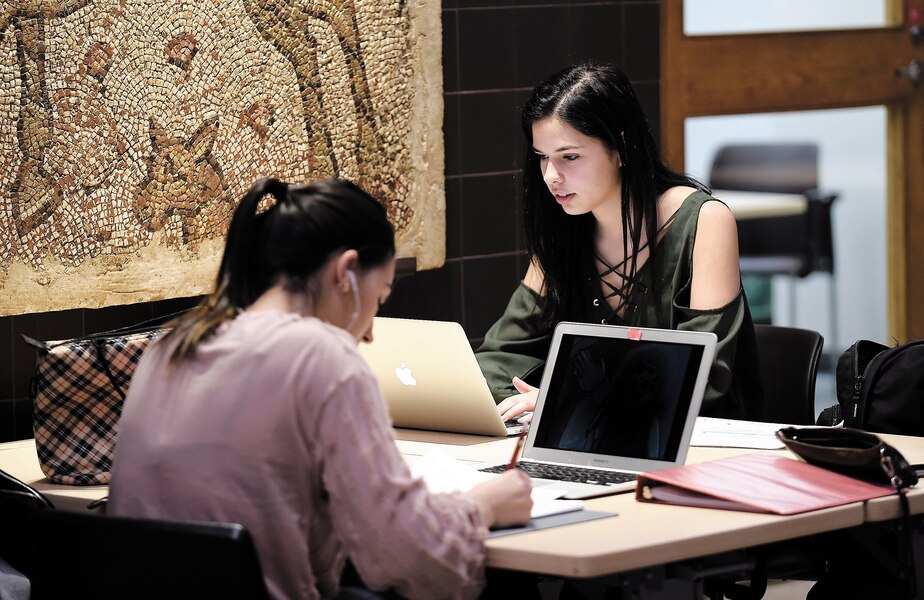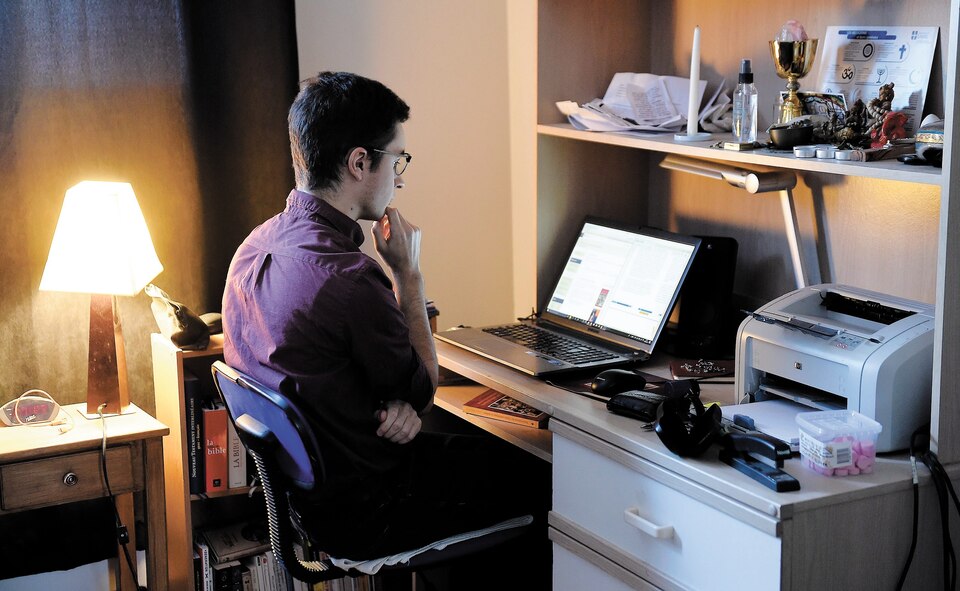Forced to take online classes

Photo Stevens LeBlanc
Ophelia Lavoie, who is studying the bachelor of communication, had to follow in spite of it four online courses on five last year, while she would have preferred to attend more often in the corridors of the pavillion Louis-Jacques-Casault, located on the campus of Laval University.

Daphnée Dion-Viens
Friday, 16 February 2018 00:00
UPDATE
Friday, 16 February 2018 00:00
Look at this article
At Université Laval, the number of distance education courses increases to a point that it is impossible to follow some courses in the classroom, on the campus.
Ophelia Lavoie enrolled in the bachelor’s degree in communications a year ago.
A native of Sainte-Marie-de-Beauce, so she decided to rent an apartment in Quebec. It is subsequently found that several of the required courses in first year are only offered at a distance and finds himself very much in spite of it with two online courses at its first session and four online courses over five to the next session.
“Having known this, I would not have signed a lease,” says the girl who has approached his student association to have access to more courses in the classroom.
The Association of students in communication to the public, it was confirmed that the large number of online courses required in the first year of the upset. “There’s a lot of students who come to talk to us,” says its vice-president external, Jérémy Michel Roy, who indicates that the situation is “corrected a bit” this year.
The communications students are not the only ones who have to take several courses at a distance. Maxence Croteau, a student in sciences of religions, despite him three on-line courses on five currently.
“You lose the richness of contact with our teachers, who are often leading experts. I have the impression to make me mortgage my education when I have too much online course “, he says.
In the ranks of the students, the opinions are, however, well shared. Some hate online classes, but others love the formula and want more of it (see another text).
Three times more
For several years already, Laval University is the academic institution that offers the most online courses in Quebec, ahead of even by far the Télé-which only offers distance education.
For the past ten years at the Université Laval, the number of enrollments in these courses has tripled, and nearly 60 % of students take at least one course at distance. In the winter of 2018, almost 10% of the classes offered are online.
Students are required to follow several online courses against their will in the first year of their studies are “the exception rather than the norm,” said Claude Savard, vice-rector for studies and student affairs.
The management wants to avoid this kind of situation, and a “continuous dialogue” is underway with the faculties, which have a high degree of independence in this chapter, ” added Mr. Savard. “Unfortunately, you can’t do it in every course “, he admits.
Increase the accessibility
The development of distance learning courses has been undertaken, there are already several years in order to increase the accessibility of university education, continues the deputy-vice-chancellor, who says that the online courses do not cost less to the university administration. The professors and lecturers are paid according to the same requirements as a classroom course, without counting the additional costs related to technology infrastructure required, ” he explains.
This new formula however, allows you to recruit new students by shattering geographical boundaries attached to the in-class training, indicates the higher Council of education in a notice published in 2015. Université Laval may not, however, specify how many additional students have been recruited through distance learning.
Categories of online courses
During synchronous : The student, regardless of where it is located, can follow the courses given by a teacher in the classroom through a web platform, which also allows him to interact with. At Laval University, the courses are synchronous, which come closest to teaching a class, represent 15% of a distance course.
During asynchronous : The student may make his or her courses at a time that suits him. The form varies according to the course, which may include readings, forums, quizzes, video clips, etc, The vast majority of these courses includes at least one examination under supervision.
Three times more registrations in online courses at the University of Laval
Enrollments in distance learning courses
2006-2007 : 24 016
2016-2017 : 74 337
940 courses distance offered, including 471 in the winter of 2018
102 programs that can be made to the full distance (including two bachelor’s degrees and a majority of the certificates or firmware)
60 % of all courses offered at a distance have been exclusively available online
60 % of Laval University students are enrolled in at least one distance course
9 % of the courses in the winter of 2018 are in line
15 % of all the programs offered at the UL can be carried out remotely
Source : Université Laval
Do his bachelor’s degree from Quebec in his living room

Photo Stevens LeBlanc
Maxence Croteau, who studied science of religions at the University of Laval, would like to have more courses in the classroom rather than having to do several on-line courses, sitting at his work desk in his apartment.
While students hate online classes, others love the formula and want more of it.
Jean-Christophe Bourgault studied at the bachelor’s degree in software engineering. It is currently two courses online and love the formula. “I really like that “, lance-t-il.
The video clips offer great flexibility, ” explains the student. It is easy to see two times the same capsule, if a concept has been misunderstood, and, conversely, to pass bits, if the material is considered to be easy.
Jean-Christophe prefers by far the tranquillity of her apartment in the hubbub of the larger classrooms.
“It allows me to be alone, without noise. It’s better than being stuck in the back of an auditorium with nothing to look forward “, shows-t-it. At the Faculty of science and engineering, there are on average 150 students in a lecture room in the bleachers.
Great flexibility of schedule
Several other students with whom The Journal spoke to appreciate the great flexibility of schedule, including the fact of not having to be stuck in traffic in the morning to get on campus. However, some have pointed out that it takes more willpower and organisation to succeed in a distance course.
For its part, Maxence Croteau, who studied science of religions at the University of Laval, would like to have more courses in the classroom, but nevertheless believes that an online course per session is acceptable.
Contrary to what you might think, the typical profile of those who are taking online courses is not the student of over 25 years who does a back to school while juggling work and family obligations.
Several full-time students, aged 18 to 24 years of age, opt for one or two distance learning courses per semester, says Nicolas Gagnon, director of the Office of teaching support at the University of Laval.
According to a survey conducted in 2015 by the CADEUL, which represents undergraduate students, 80 % of those who enroll in distance courses also study on campus.
Experience with variable geometry
Always according to this same stroke of the probe, 24 % of students consider that the content of the online course is less relevant than in a classroom setting, while only 10,78 % of the students think the opposite.
The students have also been part of experiments with variable geometry. Some report a stimulating experience where software developed specifically for the course allow students to do simulations, while others have attended courses where students are required to read the same book for 10 years, know the exam questions in advance and receive a minimum of supervision.
Distance education – A trend that is ” fairly positive “
The Confederation of student associations at Laval University, we see in the development of courses at a distance, a trend that is ” fairly positive “, considering the important impact on accessibility to studies. Its president, Samuel Rouette-Fiset, however, is “concerned” when required courses are offered only online. “It prioritizes the choice for the students,” he says. The quality of training also remains a ” constant concern “. “There is improvement, but this is not uniform,” he said. Université Laval replied that she was with tags to ensure the quality of the online training, which should be the same as the training offered in the classroom.
Increase in demand – The lecturers concerned
The president of the Syndicat des chargés de cours de l Université Laval, Christine Gauthier, is concerned with the development of “dazzling” distance learning courses in recent years. Even if it recognizes that the demand for this formula is large, it is also the dissatisfaction among students who are forced to follow a large number of online courses. “It is necessary to have as a concern the balance between distance courses and face-to-face,” she said. For us, the balance is achieved. “Laval University is expected to set to soft-pedal on the development of online courses over the next few years, she adds. “Teaching, it is above all a people business,” says Ms. Gauthier.
University network – and Soon a eCampus quebec
The online courses will be expected to develop even more in the réseau universitaire québécois in the coming years. Work is underway to establish an eCampus quebec, which could take the form of a common platform for online courses. The government Couillard sees a significant potential for this in-demand internationally, and wants the Quebec to follow suit, while the Ontario, Manitoba and British Columbia already have a virtual campus national.






